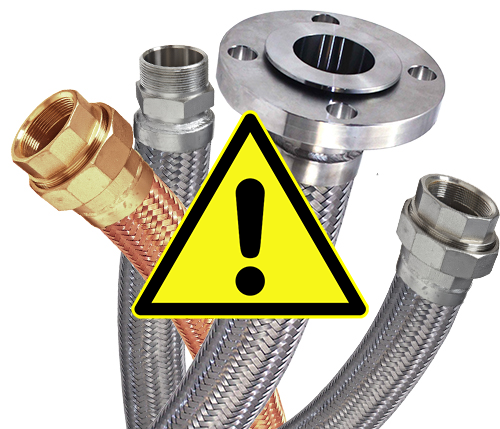
Hose safety often does not get the attention it deserves. Proper hose and fitting selection are critical to the safety of both your people and your profits. If a hose fails in a manufacturing or industrial processing operation, the entire production line becomes compromised, putting expensive equipment, product and lives at risk. Choosing the right hose and fittings can be the single most important decision to achieve safe material movement, containment and transfer. Thankfully there are safety precautions you can take to make sure disaster doesn’t strike. In fact, for FY 2019, OSHA listed Control of Hazardous Energy as the fourth most violated standard. The top three were fall protection, hazard communication and scaffolding violations. (https://www.msdsonline.com/2019/09/10/oshas-top-10-most-cited-violations-of-2019/)
Hose Type: Careful hose selection will provide greater lifetime value than the initial purchase price. S.T.A.M.P.E.D. is an industry-wide standard that helps to determine the size, temperature, application, material, pressure, ends and delivery needed. When specifying a hose, this will ensure the hose type is properly matched and safe for its intended application.
Pressure Ratings: A hose assembly’s pressure rating is only as high as it’s lowest rated component. A hose rated for 300PSI will not perform at 300PSI if the coupling method on the hose is only rated for 50PSI. It is critical to understand the assembly’s rated pressure and not simply rely on the hose PSI only. Never exceed the intended pressure ratings of your hose assembly.
Maintain Temperature: Safety concerns arise if you operate a hose outside of the hose’s specified temperature rating. Operating outside the specified temperature rating can cause small cracks in the inner tube, reduce manufacture pressure ratings and the hose will lose its flexibility.
Hose Contamination: If the fluid going through your hose carries any kind of contamination or debris, it will prematurely wear out the inner tube. Be sure to understand the hose’s chemical resistance properties. Depending on the chemical and the hose construction, manufactures may only recommend intermittent contact. Properly cleaning a hose before storage and the next use will reduce the possibility of a dangerous hose failure.
Leakage: External leakage means there is something wrong – don’t ignore it. Leaks can pose serious safety concerns for employees because they could slip and fall on the remnants. EPA and OSHA can issue fines as well. Be sure to always check state and local regulations before cleaning any kind of hose leak.
Hose Failure: Hoses are a wear and tear item; However, when a hose fails earlier than reasonably expected, completing a hose failure analysis is a good idea to try to understand why the failure exists. If you didn’t make the hose, enlist the help of the local distributor who made the hose. Recurring hose failures are an indicator that something is amiss in the application. Either a different hose needs to be selected or there is something in the application that is wearing on the hose prematurely. Understanding the root cause of the failure can lead to better hose selection for the application or finding a problem in the overall system that needed addressing. Fixing the root cause will save a time, money and certainly headaches in the long run.
Hose Storage: Storing hose should be taken very seriously. You should always check for the hose shelf life and be sure to never stack hoses. Try to store in clean and dry conditions between 50°F and 70°F and be sure to cap both ends of the hose to prevent contamination. To prevent kinking, hang so the hose is not bending more than the manufacturers recommended bend radius. Simple actions like this will greatly enhance safe hose operation.
Maintenance Log: Creating a maintenance log can help with hose safety immensely. Over time, a log will show you the frequency of hose replacement and can help you identify hoses that may have been incorrectly applied to the application. A log could also identify potential equipment malfunctions putting unnecessary stress on the hoses shortening hose life. Following a maintenance plan will ultimately prevent your equipment from lengthy and expensive downtime.
Hose Maintenance: Regular preventative maintenance can help you identify any kind of hose failures before they happen. Checking hoses on a regular basis is a simple step an organization can implement to increase employee awareness, reduce potential risk and injury to employees and increase uptime of company assets, thereby reducing unplanned financial exposures.
Hose Replacements: One of the most important safety actions you can take is to replace any old or damaged hoses. Look for things like abrasions in the cover, twisting, cracks or tight bends. Another simple step to achieve hose safety.
Hoses often carry hazardous chemicals and operate at extreme pressures. It is paramount to put safety at the forefront of any decision when using, specifying or making a hose assembly. All of our hose assemblies are manufactured, tested and certified to NAHAD standards to ensure quality performance over the life of the hose.
